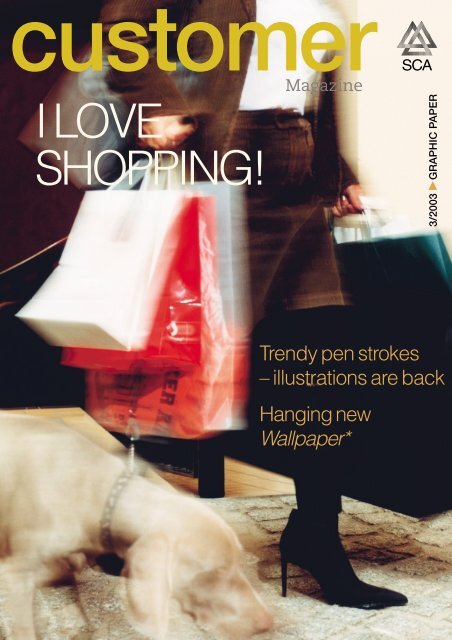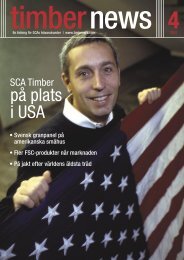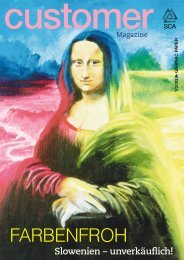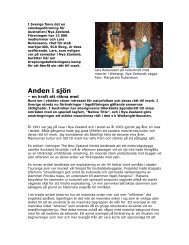Customer - SCA Forest Products AB
Customer - SCA Forest Products AB
Customer - SCA Forest Products AB
- No tags were found...
You also want an ePaper? Increase the reach of your titles
YUMPU automatically turns print PDFs into web optimized ePapers that Google loves.
customerMagazineI LOVESHOPPING!3/2003 GRAPHIC PAPERTrendy pen strokes– illustrations are backHanging newWallpaper*<strong>SCA</strong> <strong>Customer</strong> Magazine 3/2003 Graphic Paper1
Contents 3/20034 Drawing down new trendsFashion illustrations often give a magazine an exclusive feel.That’s one good reason why illustrations have achieved arenaissance in classic international mags like Vogue and Elle.Swedish illustrators are right at the top.7 Lovely ... moose cheeseUp in the far north we find Sweden’s first moose farm. Themoose are safe from the hunters’ guns and instead work hard toproduce possibly the world’s dearest cheese. One kilogramme willcost you more than 400 euros.8 Big holes in the Swiss pressThe Swiss are quite happy to read newspapers, but over the last20 years a process of media ownership concentration has leftsurvivors with positions suspiciously like monopolies.11 Good newsThe Swedish periodical Goda Nyheter is celebrating ten yearsof focusing on the positive side of life. Publisher Erkki Perssonthinks the media spend far too much time and energy onnegative news-gathering.12 Shopping is lifeShopping has been given the all-clear. It’s a healthy hobby, likegolf. Researchers have always been interested in how we behaveas consumers, and now trend-conscious publishers are launchingmagazines on the subject. The American Lucky Magazine arrivedin 2001, Sweden’s Ruby followed last winter and then came theFrench Shopping last spring.18 Pettersson’s a lumberjack, and he’s OKWhen Mats Pettersson at <strong>SCA</strong>’s Ortviken paper mill chose toreturn to his previous job in the woods, nothing was as heremembered. Now he’s working with hi-tech machines thatseem to think for themselves.20 Travellers’ friendThe International Herald Tribune is written for people who moveacross continents and who are at home in different cultures. Avoice in the global village.22 New Wallpaper*, same wallAfter six years and nine months, Britain’s Wallpaper* has beenrelaunched. Editor Jeremy Langmead says it should be viewed astimeless, sexy and sophisticated. Just like before, then. But different.<strong>SCA</strong> CUSTOMER MAGAZINE, GRAPHIC PAPER. International magazine for the graphicsand media industries, published by <strong>SCA</strong> <strong>Forest</strong> <strong>Products</strong> <strong>AB</strong>, Box 846, 851 23 SundsvallTELEPHONE:+46 60 19 40 00 TELEFAX: +46 60 19 40 90EDITOR-IN-CHIEF: Anne-Sofie CadeskogRESPONSIBLE UNDER SWEDISH PUBLISHING LAW: Peter NyquistPROJECT LEADERSHIP: Luise Steinberger/Elisabet Tapio NeuwirthE-MAIL: luise.steinberger@chello.se/ red.media@comhem.comENGLISH EDITING: Greg McIvorGRAPHIC DESIGN: Mellerstedt DesignPRINTING: Accidenstryckeriet, SundsvallCOVER PHOTO: Olle MelkerhedThe content of this magazine is commissioned, checked and approved by the editorialteam. This does not mean that the editorial team or <strong>SCA</strong> necessarily share all opinionsexpressed by individual writers.Would you like your own copy of <strong>SCA</strong> <strong>Customer</strong> Magazine, or one to give away to acolleague? Contact us with your name, address and company name where appropriate:<strong>SCA</strong> <strong>Forest</strong> <strong>Products</strong>, Margaretha Wallström, 851 88 Sundsvall. Telephone: +46-60-19 3495 Telefax: +46-60-19 31 34. E-Mail: margaretha.wallstrom@sca.com<strong>SCA</strong> FOREST PRODUCTS produces publication papersfor newspapers, magazines and catalogues, pulp,solid-wood products and forest-based bio-fuels.<strong>SCA</strong> <strong>Forest</strong> <strong>Products</strong> also manages <strong>SCA</strong>'s extensiveforest holdings, supplies <strong>SCA</strong>'s Swedish industrieswith wood raw materials and offers cost-efficienttransport solutions to <strong>SCA</strong>'s units.Group turnover is around SEK 13,500 million andthe company has 4,000 employees. <strong>SCA</strong>'s forestryoperations are certified in accordance with thestandards of the <strong>Forest</strong> Stewardship Council (FSC).4 Not many artists canlive on their drawingsof clothing. But fashionillustration is on theway up.12 The shopping baghas new company.Shoppers now haveglossy magazines tohelp them through theconsumer jungle.18 Mats Petterssondoes one of the paperindustry’s central jobs:he fells the trees theymake paper from.Peace,love andpaperNEVER BEFORE – in modern timesat least – have people shown suchinterest in fine paper. Special storesoffer small sheets of paper to writenotes on, invitations and thankyous,as well as paper designed forbeautiful calligraphy.“Trends in interior design directhow the paper should look,” saysUlrica Meyer, shop manager of onesuch exclusive boutique.Most customers buy strict,restrained paper, which is perhapsa pointer to the current economicclimate. But those who’re lookingfor something with a little morestyle often select a thin, extremelyglossy mother-of-pearl paper.However, the trend is changing.At the Paper World event in Frankfurt,reports said that flower powerand retro patterns from the 1970s,complete with their typical broadcolour spectrum, are on the way in.Should we laugh, or cry?New colleaguein AustriaDIETER MAYR has joinedthe customer serviceteam at <strong>SCA</strong> GraphicLaakirchen from the technicalservice departmentat paper merchants PVVDeutschland, where hehas worked for the lasteight years. A trained offsetprinter, he spent a fewyears at Körner in Sindelfingen,Germany, before DIETER MAYRcompleting the Johannes-Gutenberg-Schule coursein printing technology, and has a closeworking knowledge of markets insouthern and eastern Europe.2 <strong>SCA</strong> <strong>Customer</strong> Magazine 3/2003 Graphic Paper
World-class RESEARCH CENTREAN INTERNATIONAL externalevaluation group has praised theco-operation between MitthögskolanUniversity and industry in the northernSwedish town of Sundsvall. TheFibre Science and CommunicationNetwork (FSCN) is the university’sresearch centre for the forestryindustry in which <strong>SCA</strong> GraphicResearch plays an important role asco-financial backer and partner. Theevaluation group said the FSCN wasa powerful scientific resource that hadalready attained world class in itsresearch into the industrial use ofwood fibre. The group predicts itsresearch will continue to yieldresults.“We were co-founders of theMitthögskolan forestry researchdepartment, and for us it wasa chance to focus on productdevelopment and research thathas industrial relevance,” says ÖrjanPetterson, chief executive of <strong>SCA</strong>Graphic Research and chairman ofthe FSCN research project.“It’s becoming more importantto satisfy our customers’ calls forus to refine our products and wehave to lead that development.The research has already realisedconcrete results, so we’re happyto invest resources here.”Did youknow......that Eloff has passedaway? Eloff was the eagleowl who achieved famethroughout Sweden inFebruary 1999 when heflew into power cablesand blacked out 50,000households and <strong>SCA</strong>’splant in Sundsvall.Damages ran into severalmillion euros. Eloffwas injured too, and hiswings stopped growing.Experts believe Eloffdied from the effects ofthe crash, even thoughit happened four yearsago. He reached the ageof ten.Film stars in leavesand pine needlesLegolas (Orlando Bloom) and Aragorn (Viggo Mortensen) encounterthe Ents in the Fangorn forest.HAVE YOU SEEN “The Two Towers”? No? Do so, and you’ll besurprised.The film’s greatest heroes are in fact trees. When things seemdoomed, a race of tree-people called Ents turn up and save the day.Creating a tree army called for thousands of man-hours at thespecial effect computers. If you liked the movie, we recommendyou read JRR Tolkien’s trilogy. In the books the Ents play an evengreater role, but sadly much of their work had to be cut in thefilm version.<strong>SCA</strong> <strong>Customer</strong> Magazine 3/2003 Graphic Paper3
4 <strong>SCA</strong> <strong>Customer</strong> Magazine 3/2003 Graphic Paper
IllustrationsIN FASHION!They’ve been on the ropes for decades, but now fashion illustrationsare ... back in fashion. Weighty tomes are being written on thesubject, exhibitions are being held, and more and more magazinesand newspapers are using illustrators.TEXT Imke JanoschekILLUSTRATIONS Liselotte Watkins, Kristian Russell1994, NEW YORK CITY. A young Swedishwoman summons up her courage andphones a friend who knows someonewho knows someone at departmentstore Barneys, famous for its elegantad campaigns by French fashion artistJean-Philippe Delhomme.“When you’re young and confidentyou do things like that,” says LiselotteWatkins, a Swede who’s now oneof the world’s best-known fashionillustrators.Watkins certainly has an eclectic trackrecord, having worked for Vogue in theUK, US, Japan and Italy, for ItalianAmica and Elle in the US, UK, Germany,Sweden and France, for Wallpaper*,and for companies and brandslike Barneys, Max Mara, Anna Sui,and Marks & Spencer.She commutes between Stockholmand New York and is often involvedwith UK Vogue and Swedish Elle.“Lots of times people ask how I succeeded.But a lot of it is just doingthings, daring to go for it,” she says byphone from New York.ARTISTS INTERPRET THEIR ERAThroughout the past century, fashionillustrators have had to be brave as wellas skilled to succeed in an artistic professionwhere employers’ attentionspans ebb and flow as quickly as fashiontrends. Things were easier in theearly 1900s, when demand for illustratorswas greater than today. Photographswere still too blurred to showclothing details, so fashion illustratorshad the chief responsibility of providinga feeling and look for the general public.French magazine La Gazette du bonton, first published in 1912, is reckonedto be one of the first trend periodicals,and it assembled the best illustrators ofthe age to interpret the new fashions.After World War II, illustrators experiencedanother boom as the end ofhostilities meant fashion was onceagain comme il faut. Newspapers reportedon the length of skirts and silhouettechanges and employed contractedillustrators. However, the end ofthe sixties saw photographers grab thebaton and run with it, and illustratorswere forced out of the limelight. It stayedthat way until the beginning of thenineties.WALLPAPER* BROKE THE TRENDAccording to Laird Borelli, a historianat New York’s Fashion Institute ofTechnology and author of the book“Fashion Illustration Now”, it was Barneysthat paved the way with a series ofdrawn advertising campaigns between1993 and 1996. She also accords greatimportance to lifestyle magazine Wallpaper*,which hit the shelves in themid-nineties.“Wallpaper* was a real breakthrough,”says Watkins, who hasworked both for Barneys and Wallpaper*.She sees a number of reasons forfashion mags and daily papers turningto illustrations for their fashion articles.One is that working with fashion hasstreet credibility once again. Ten or 15years ago, fashion was still regarded asa superficial and rather unintelligentway of earning your pay.<strong>SCA</strong> <strong>Customer</strong> Magazine 3/2003 Graphic Paper5
“Another reason is that fashion photographyhas arrived at a crossroads,”Watkins continues. “These days somuch of it is about shock value. Whenfashion photographers are showingmodels having sex with sheep thenyou’ve gone about as far as you can go.Fashion illustrations are a way out.You can go a long way with a drawing“Naturally, fashionillustrations followdevelopments infashion itself.”LOTTA AHLVAR, CEO SWEDISH FASHION COUNCILand be as daring as you like withoutreaders being put off. I think we’ll seemuch more of that: daring, thoughtprovokingfashion illustrations that areno problem to publish.”ILLUSTRATIONS FEEL LUXURIOUSWatkins believes fashion photographyoften comes close to illustration. Photosare computer-manipulated, collagesare common and drawings are oftensuperimposed on a photographed background.The boundaries between photographsand illustrations are blurring. Anotherreason for magazines to buy illustrationsis that they’re relatively inexpensive.“It’s a relatively small cost if youcompare it with the cost of paying aphotographer, a stylist and a bunch ofLiselotte Watkins, known for her sophisticated style, is protective of the girls shecreates: “They’re often inspired by people around me or photographs.”models for a fashion job,” Watkins says.A fashion illustration also gives apublication an exclusive feel. It showsthat someone has put a lot of effortinto a piece of art, even though the illustrationsare often created using acomputer. On the other hand, illustrationswill never be able to competewith fashion magazine photos of newclothes worn by glamorous models.Advertisers like Gucci would probablybe unamused if a pair of their trouserswere portrayed by a drawing ratherthan a photograph. Photographshave a much stronger advertising effect.CROWDED MARKETWatkins is one of few Swedish artistswho make their living almost entirelyfrom fashion work. Most of her colleagueshave to divide their time betweenfashion and other branches.“The market in Sweden is far toosmall,” says Nina Beckmann, one ofthe founders of Agent Form, a Swedishagency handling illustrators and graphicdesigners. Agent Form represents talentslike Watkins, Anglo-Swede KristianRussell, and Lovisa Burfitt andJane Bark.“Sure, the interest in fashion illustrationshas grown,” says Molly Bartling,a Swedish illustrator who works foremployers like the Swedish FashionCouncil and the country’s top dailybroadsheet, Dagens Nyheter. “A lot isbeing written about it, not least sincethe Catwalk exhibition about Swedishillustrations was shown at the CultureHouse in Stockholm and in Paris. ButI don’t think it has really led to anincrease in demand.“When I graduated from the Univer-6 <strong>SCA</strong> <strong>Customer</strong> Magazine 3/2003 Graphic Paper
sity College of Arts, Crafts and Design,making a living from fashion illustrationwas still regarded as a flight of fancy.These days, illustrations are part of thescene in a whole different way, and lotsmore people are involved.”STYLE IS CRUCIALWhen a fashion illustrator has establisheda certain personal style it’s crucialto stay abreast of new trends.“Naturally, illustrations follow thedevelopments in fashion itself,” saysLotta Ahlvar, chief executive of theSwedish Fashion Council.“During the 1980s, fashion drawingswere airbrushed, then along came MatsGustafson with his fantastic water colours.Today there’s a range of differentstyles. Line or computer-generated. Someartists work in a rough, scratchy style,others with perfect surfaces. You haveto find your niche.”Laird Borelli divides today’s illustratorsinto three categories: sensualists likeGustafson, Ruben Alterio and FrancoisBerthoud who paint beautiful, almostimpressionist pictures; sophisticatedtypes like Watkins and Jean-PhilippeDelhomme; and creators of futuristic,computer-animated forms like KristianRussell or Jason Brooks, to name but afew.LIVING ILLUSTRATIONSHow does a fashion artist develop apersonal style? How do they stay intouch with trends? For Watkins, it allcomes naturally.“The other day I was looking at someold drawings from my Wallpaper* days.That style feels foreign to me now. Youfind other interests in life and that is reflectedin your art.”However, she would never expose herbeautifully drawn models to tough,trend-conscious manipulation.“Never. I know my girls so well – Ilive with them! They are often inspiredby people around me or photographs,so I’d never humiliate them by drawingthem having sex with sheep or anythinglike that.”○ ○ ○ ○ ○ ○ ○ ○ ○ ○ ○ ○ ○ ○ ○ ○ ○ ○ ○ ○Sources:Fashion Illustration Now, Laird Borelli,Thames and Hudson publishing.Catwalk – Swedish Fashion Illustrations,Illustrator Centre and Arvinius Publishing,Form Publishing.Make friendswith a mooseIt would be a hunters’ paradise,were it not for the absence ofshotguns. At Moose House inBjurholm, northern Sweden,you get the chance to get upclose to the king of the Swedishforests. Apart from having Charliethe moose shake you by thecloven hoof, you can sampleblue moose cheese too.TEXT Mats Wigardt PHOTO Bo FernströmWHEN CROSS-COUNTRY SKIER ChristerJohansson, a world champion in 1978,returned to his parents’ farm in the farnorth of Sweden in the early 1980s, herealised that it would take more thanjust the area’s natural beauty to attracttourists. His answer was the moose and,together with his wife Ulla, he startedSweden’s first moose farm.STROKE, RIDE AND MILK ’EM!Every year about 30,000 people visit theMoose House to view Charlie the mooseand his 14 tame friends in the enclosureat close range and to stroke and photographthem. And maybe even to get achance to ride one.Having spent several years with theJohansson family, the moose are so unafraidthat they even allow themselves tobe milked. However, the process calls forpeace and quiet and plenty of patience aseach milking can take up to two hours.At most, the result is a couple of litresof energy-rich milk.“The next step was to try to makecheese from the milk,” says Daniel Johansson.He’s the family’s son and plays aleading role in all the farm’s variousCow’s milk contains just over two per centfat, while moose milk has a fat level of almosteleven per cent. This gives moosecheese a very mild, perhaps buttery,flavour. “Deep” and ”mature” are words theconnoisseurs use. The cheese is not unlikethat from cow’s milk, but much fatter.activities, ranging from organising outdoorevents and guiding tours to overseeingcheese-making and the restaurant.FOUR HUNDRED EUROS PER KILOIn Russia they’ve long used the fat andprotein-rich moose milk for medicinalpurposes, treating maladies such asstomach ulcers and cancer. Surprisingly,though, the Moose House is the first suchestablishment in Sweden to use moose milk.The cheese-making takes place threetimes a year. In collaboration with scientistsand top dairy experts, chef Ari Achrénhas developed three kinds of creamy cheesebased on pure moose milk: a blue cheese,a white cheese, and a Greek-style feta.“Three moose cows give milk for threemonths after having calved, which isenough to make between 250 and 300kilos of cheese per year,”Daniel Johanssonexplains.It’s not cheapthough. At a costof almost 400euros per kilo itmay well be theworld’s mostexpensive cheese.But why not?You are, after all,tasting the king ofthe Swedish forests!<strong>SCA</strong> <strong>Customer</strong> Magazine 3/2003 Graphic Paper7
Switzerland has more newspapers andmagazines per person than any other country,yet its press diversity is under threat. Fallingreaderships and a devastating advertisingslump are seen as the prime culprits.Uncertain timesfor Swiss mediaTEXT Martin Arnold PHOTO IBLTHE SWISS ARE avid newspaper readers.With 385 copies printed per 1,000 people,no other country can boast a higherper-capita density of printed media.Switzerland’s seven million people areserved by a market of some 2,500 titles,most of them trade journals. 224 of themare newspapers and magazines, which is67 titles fewer than seven years ago.The Swiss media landscape has undergoneconsolidation in the last twodecades, a process that’s threatening thecountry’s unique brand of democracy,founded as it is on regional plebiscites.This is because many of the titles thathave disappeared were aimed at localor regional audiences, while those thathave survived have acquired monopolisticmarket positions.“We have no guarantee that there’llbe a public debate about the issues priorto a plebiscite,” explains Roger Blum, amedia researcher in Berne.WORLD PERSPECTIVETwenty years ago, political party-affiliatednewspapers used to vie for readers’attention. Today, the Social Democraticand Christian Democratic press hasvirtually disappeared, while other regionaland nationally oriented mediahave become “Forumsblättern” nonparty-political.Roger Blum isn’t overly perturbed bythis trend. “A person who subscribed toa single newspaper twenty years agowould have got more one-sided informationthan is the case today,” he says.In fact, readers interested chiefly innational and international affairs nowhave a wider choice than ever before.Seven Sunday newspapers and a diverserange of financial publications andweekly magazines are all at their disposal,as well as the German news magazinesDer Spiegel and Focus, and theDie Zeit newspaper, all of which havestrong circulations in Switzerland.In French-speaking areas populartitles include Le Temps and le Journalde Genève, while Italian speakers havetheir own publications, such as Corrieredel Ticino and Giornale del Popolo.MAJOR MEDIA ROLEThe Swiss are the world’s greatest railtravellers, and commuters enjoy readingtheir morning papers as they hurtlealong the tracks. Zurich, the largestcity, hosts two leading titles, NeueZüricher Zeitung (NZZ) and Tagesanzeiger,both sharing conservative contentand design. Young people preferthe freesheet 20 Minuten.What of the alternatives? One such -breakfast television – has never caughton in this nation of newspaper lovers.A sudden proliferation of private TVchannels ten years ago ended with aheadlong retreat by financial backerswhen they discovered that viewers preferredtheir newspapers after all.The media play a prominent rolein Swiss life. The country has 129journalists for every 100,000 inhabitants,compared to 66 in Germany and46 in France. Advertising volumeis higher than anywhere else inEurope and 70 per cent of it ischannelled via newspapers andmagazines, well over the Europeanaverage of 55 per cent.AD REVENUE SLUMPYet not even Switzerland’s ad markethas been immune to the current recession.Advertising revenues have plummetedsince March 2001 and are now8 <strong>SCA</strong> <strong>Customer</strong> Magazine 3/2003 Graphic Paper
Street plebiscites, with votes decided ona show of hands, are one of the buildingbricks of Swiss democracy. Being able toexercise one’s vote requires informationabout local matters, which is why localnewspapers are so important.below the 1997 level which is generallyregarded as an industry low point.Many publishing companies havelost money after ploughing their budgetsinto private TV channels and theInternet. A number of newspapers,among them major titles with circulationsof 100,000 or more, have just athin layer of capital left. Editorial departmentsare being downsized andeven NZZ, faced with no imminentmarket upturn, is laying people off.The slump has hit local newspaperswith small circulations of less than10,000 particularly hard and the Swissparliament is currently discussing apossible injection of extra funding forthese titles.Media researcher Roger Blum saysthe idea is a good one, considering theimportance of small newspapers inSwitzerland, but he believes it will proveharder to translate into practice.“Newspaper ownership structures“A person who subscribed to a singlenewspaper twenty years ago would havegot more one-sided information than isthe case today.”ROGER BLUM, MEDIA RESEARCHER<strong>SCA</strong> <strong>Customer</strong> Magazine 3/2003 Graphic Paper9
○ ○ ○ ○ ○ ○ ○ ○ ○ ○ ○ ○ ○ ○ ○ ○ ○ ○ ○ ○ ○ ○ ○ ○ ○ ○ ○ ○ ○are often unclear. You often find thatlarge publishing firms have shareholdingsand want their share of the profit.”LANGUAGE PRESERVATIONThe Swiss also operate another form ofmedia subsidy. Tessiner Fernsehen, alocal public service, Italian-languageTV station in the canton of Ticino, hasfared well despite competition fromItalian channels. But it would neverthelessbe unable to broadcast programmesto its 300,000 viewers without statesubsidies. And without subsidies therewould be no special programmes onnational TV for Switzerland’s 30,000Rhaeto-Romansh viewers.The most recent example of targetedsubsidies is the provision of funds bythe national parliament and Graubündencanton to the Rhaeto-Romansh newsagency. Without this, the La Quotidiananewspaper, published in the RumantschGrischun language, couldn’t hope tosurvive.Blum wants an extension of subsidiesaimed at ethnic minorities. After all,Switzerland has more foreigners in relationto its native population than anyother country, and increasing numbersof people speak Serbo-Croat, Turkish,Albanian, Spanish or Portuguese.“High quality newspapers and magazinesthat are loyal to the host countrywould help underpin integration,”Blum says.Today, immigrants represent twentyper cent of the population. And whilethey do have media outlets, these areoften multicultural radio stations witha very restricted audience.Some observers believe a new wayforward may be the arrival of moreforeign newspapers. Yet before thishappens more titles will close down andmedia diversity – though still extensiveby European standards – will declinefurther.Follow thy neighbourSWITZERLAND HAS a population of 7.2million living in a nation divided upinto 25 cantons. Unemployment is3 per cent, while the average annualwage is around 33,000 Euros. Fourlanguages have formal legal status:German, French and Italian are officialtongues, while Rhaeto-Romanshis a national and partly officiallanguage.Laws, tax forms and other officialdocuments are translated into theselanguages. Yet there is little mediacross-over between different languageareas since people prefer publicationswritten in their own tongueand that take their cue from their“mother country”. For Swiss Germansthis is Germany, while thewestern Swiss look to France andTicino people to Italy.Printed media receive postagesubsidies via hidden state appropriations,and Swiss newspapersare no more expensive to buy atthe newsagents than anywhereelse in Europe. But their primesource of finance remains advertising– a market that has shrunkdramatically in recent years.10 <strong>SCA</strong> <strong>Customer</strong> Magazine 3/2003 Graphic Paper
At Goda Nyheter they think reading thenewspaper should be fun.THE BRIGHTERSIDE OF LIFEGood journalism is often associated with criticalexamination of negative events or conditions. But inSweden’s second city of Gothenburg one magazinedevotes all its time sniffing out life’s successes.TEXT Catrin Reth PHOTO Olle MelkerhedGODA NYHETER (“GOOD NEWS”) is thatrare thing – a magazine that’s decided tohighlight the brighter side of life. PublisherErkki Persson believes today’smedia focus far too much on negativenews. Do we really have to read allabout every accident, see the repetitivedetails of each new disaster, or endurethe scandal-filled exposés of people whohaven’t managed to live a perfect life?Persson is, of course, well aware ofthe media’s important investigative rolein society, but says there must be a balance.“It’s been proven that people don’treact well to this blanket coverage ofaccidents and other tragic events – by itsvery existence this magazine questionsthe huge amount of space the mediagives to life’s negative sides.”STRONG LOCAL PROFILEPerson seeks to highlight the efforts ofordinary people. That can mean anythingfrom running a business to developingnew ideas, or from working onprojects for the poor to spreading happinessas an artist. His magazine is tenyears old, comes out quarterly and hasa circulation of 7,700. A strong featureis its coverage of local coastline industries– shipping, harbours and docks,technology and environmental firms.A natural consequence of his 30 yearsspent working as an engineer at Gothenburgdocks.“It was when I wrote a book aboutmy years in charge of the city docksthat I began to express my dissatisfactionwith the negative press coveragewe were getting. I thought someoneshould publish a magazine filled withgood news. There were others whoshared my opinion, so we just gotgoing.”COMPANIES AND HOUSEHOLDSFinancial pressures have forced thesmall editorial team to make cuts,which in practice means that Perssonwrites most of the material himself. Butthere’s no lack of stories for his faithfulreaders thanks to his wide network ofcontacts. Some of these come from thesubscribers themselves, most of whomare companies with multiple subscriptions,though 2,000 households aroundSweden also subscribe.The magazine, which calls itselfan “oasis in themedia desert”, isalready planningfor the future.Persson is growingold and hasbegun lookingaround for peopleto take overas editor.But, he stresses:“They have toshare the rightvalues. Reporters from the local dailypaper need not apply!”<strong>SCA</strong> <strong>Customer</strong> Magazine 3/2003 Graphic Paper11
SHSome people shop to feel happy. For others, it’s a wayof defining identity. Consumption isbecoming more and more a questionof buying into and exercising theyourlifestyle you choose. Meanwhile,experts are meticulouslyexamining our shoppinghabits – and trend-huntingpublishers have caughtthe scent.12 <strong>SCA</strong> <strong>Customer</strong> Magazine 3/2003 Graphic Paper
OPHAPPYself“Traditionally, women buy things thatare visual. Men’s purchases are calledintellectual.”<strong>SCA</strong> <strong>Customer</strong> Magazine 3/2003 Graphic Paper13
TEXT Elisabet Tapio Neuwirth PHOTO Olle MelkerhedSHOPPING IS NOW politically correct.It’s even been upgraded to the status ofleisure activity, just as respected as golf,or sailing. Airlines offer one-day tripsto your favourite shopping metropolis– London, Milan or Paris. The storesthemselves have worked out that merelyoffering the customer a range of goodsis no longer enough. The whole experiencehas to be just right, which hasmeant boutiques and shopping mallsoutdoing themselves, and each other,to help consumers shop themselveshappy. In the US, some stores haveeven transformed themselves intotheme parks.Publishers with a keen sense forupcoming trends are now coming outwith special magazines for women whohave shopping as a hobby. And beforeyou cry sexism, it’s still mostly womenwho obey and cultivate their shoppinginstincts, even if younger men have begunpopping into shops for a spot ofconsumption. Just for the fun of it.One of the first such publications onthe western market was the AmericanLucky Magazine, launched in 2001.Last winter, Sweden saw the coming ofRuby, followed in France this spring byShopping. The inspiration originallycomes from Japan, where magazinecatalogues – “magalogs” – have beencommon for years.TRENDY READERS“People who love shopping usuallyalso want to know what’s hot andwhat’s new,” explains Sue Eccles, lecturerat the marketing school at LancasterUniversity in the UK. “Theywant to be kept updated, and whenthey read a shopping magazine they getthe chance to go deeper into the subjectsthey’re really interested in.”Eccles, who researches consumerbehaviour, is quick to point out thatshopping mag readers are by no meansmore superficial characters than youor I, in case you might be tempted tothink that.“Women who usually read women’smagazines are sure to enjoy readingabout emotional and spiritual issuestoo, but this is a special magazineaimed at their lifestyle.”Because, let’s face it, being a shopperis all about lifestyle. It’s not aboutentering the first shop and emptyingyour purse (or wallet!). For women it’soften an opportunity to maintain orpursue their social network of contacts– a way of combining “business” withpleasure. First you go out shoppingwith friends, then you go on to lunchand the chance for some conversation.A specialised magazine can help addquality to the occasion.“Lots of women enjoy spreadingtheir knowledge and the informationthey have absorbed. For them thismeans interesting topics of conversationover a café au lait,” Eccles says.For example, a girlfriend might tellyou which mascara got the best resultsin the latest consumer test.“The thing is that people who likeshopping also like to share. That’s alsopart of the lifestyle, just like activelysearching for the latest, the best or theprettiest.”SHOPPING INSTINCTScientists are studying the role andbehaviour of humans as consumerswith growing interest. All kinds ofstudies are carried out to determinehow we behave once we enter the templesof consumption. We’re oftenaware of the simple psychology thatlies behind why packets of sweets areplaced at eye-level just in front of thesupermarket checkout, but what wedon’t grasp is our tendency to pick upitems we don’t really need. After all,don’t we all have a jacket or a blousethat gets no further than some darkcorner of the wardrobe?14 <strong>SCA</strong> <strong>Customer</strong> Magazine 3/2003 Graphic Paper
○ ○ ○ ○ ○ ○ ○ ○ ○ ○ ○ ○ ○ ○ ○ ○ ○ ○ ○ ○ ○ ○ ○ ○ ○ ○ ○ ○ ○ ○ ○ ○ ○ ○ ○ ○ ○ ○ ○ ○ ○ ○ ○ ○ ○ ○ ○ ○ ○ ○ ○ ○ ○ ○ ○ ○ ○ ○ ○ ○ ○○ ○ ○ ○ ○ ○ ○ ○ ○ ○ ○ ○ ○ ○ ○ ○ ○ ○ ○ ○ ○Some psychologists believe thatwomen’s shopping trips are an inheritedimpulse, part of the theory of men ashunters and women as collectors.UK researcher David Lewis claimsthat men and women react in differentways when in a shop, with men themore easily stressed while women areFrom uglyduckling to swanFEW PEOPLE had much faith in LuckyMagazine when it first landed on USmagazine shelves two years ago. Itwas mocked for its catalogue-styleformat and myopic focus on shopping,and few believed it was setfor a long life. Today, this monthlymagazine’s reputation has undergonea revolution: Lucky is everybody’sdarling.When asked by Condé Nast Publishingto start a new fashion mag,editor Kim Frances, the mastermindbehind the success, initiallysaid no. Today she’s lauded as ashopping guru and media revolutionary,though she’s first and foremosta journalist and that’s howshe wants to stay.Now with a circulation of818,000, Lucky has won plaudits asthe “most honest fashion magazinein the business”, though othersaccuse it of superficiality.“Lucky has no ambitions to, shallwe say, find a cure for cancer,”Frances responds. “That doesn’tmean we don’t care, it just meansLUCKY MAGAZINEwe’re something else.” In this case,shopping.The magazine differs from otherwomen’s titles in that no articlesstray from the main subject. Thepublication is a tool that helps thereader to spend money, featuring“must-have” pages with informationon a product and where it can bebought. Good-looking pictures andeasily accessible copy attract theeye, and invite comparisons. Part ofthe joy of shopping is finding theright item at the best possible price,and budget as well as luxury priceclasses are covered. One missingelement – and actually this is muchappreciated by many female readers– is the usual bunch of supermodelswho make any comparison with thereader’s looks less than flattering.The concept now has loyal followersin the US, and on the toughAmerican market advertisers arelining up to back it.About 35 per cent of the magazine’spages are filled with advertising,a figure that has persuaded otherpublishers to copy this ugly ducklingthat grew up to be a swan. CondéNast Publishing is now planning asimilar magazine for men.“Younger menare shopping inthe same way aswomen. They buyclothes, accessoriesand skincare productslike aftershave all bythemselves.”SUE ECCLES, MARKETING LECTURERFACTFILESue Eccles lectures at LancasterUniversity’s marketing school inthe UK, where she researches consumerbehaviour, in particularextreme shopping habits. She hascarried out research on Britishwomen who have trouble controllingtheir buying impulses. But“I’m not much of a shopper myself”,she admits.<strong>SCA</strong> <strong>Customer</strong> Magazine 3/2003 Graphic Paper15
○ ○ ○ ○ ○ ○ ○ ○ ○ ○ ○ ○ ○ ○ ○ ○ ○ ○ ○ ○ ○ ○ ○ ○ ○ ○ ○ ○ ○ ○ ○ ○ ○ ○ ○ ○ ○ ○ ○ ○ ○ ○ ○ ○ ○ ○ ○ ○ ○ ○ ○ ○ ○ ○“Aren’t you ready yet?” Men findshopping more stressful than women,according to UK research.less affected. Perhaps the differencebetween the sexes comes down to attitude.“There’s been a change,” says Eccles.“We’ve seen a generation shift inour research. Younger men are shoppingin the same way as women, buyingclothes, accessories and skincareproducts like after-shave on their own.They’re no longer content to rely onthe advice of their mothers or partners.They have their own tastes.”Shopping and holidays belong together.A woman’s favourite autumntrip is a weekend in a big city withplenty of time to hit the shops, accordingto a Norwegian study by Feedbackresearch for travel agents Prisma andpublished in the Verdens Gang news-SHOPPINGFrench womenlove theirboutiquesTEXT Jean-Paul PouronSHOPPING is the first magazine ofits kind in France. It’s like a mixbetween the catalogues La Redouteand La Gazette Drouot and it functionsas an encyclopaedia of thelatest trends.“Women love to shop and previouslythere’s been no magazinecatering to what is a woman’s favouritesport. Shopping meets thatneed,” says editor Maryse Bonnet.The title is published by PrismaPresse, the second-largest publisherof weekly magazines in Franceand part of the German giantGruner + Jahr.Shopping was first regarded as apossible supplement in a magazinecalled Femme Actuelle, but legalproblems (for tax reasons it’s notprofitable for a weekly to producemore than eight special issues peryear) meant Shopping arrived as aseparate publication. It’s also receivedplenty of marketing space inthe group’s other magazines, Voici,Gala and Femme.The magazine is aimed at a limitedaudience, i.e. women aged between 25and 40. The idea is to be a trend bibleand practical guide, a reflection of newlifestyles, and a source of ideas foranything from cosmetics to interiordesign and hairstyles for dogs.The editorial staff stand squarelybehind Shopping’s direction. “There’sa constant hunt for new talents, thebest fashion, the best addresses, discoveringnew trends, crazy ideas anda desire to share personal favourites.We’re not here to be content with windowshopping. We want to help peopleto shop in a carefully planned way,”Bonnet says.“In 132 pages we’ve managed toassemble pretty much everythingwomen care about: fashion, makeup,accessories, furnishings, books, travel,health and more in a selective andmodern way, almost as if we’re a hugedepartment store. Shopping is a mapfor various trends, a guide, a treasurechest of joy.”Under the heading “lifestyle”, forinstance, you can read that the “practicalfamily” can travel to Stockholm,a city where children aretreated like royalty. The “chic family”goes to Mauritius as there’s notime difference. The “trendy family”will fly to Beijing, because next yeareveryone else will go there.As the second issue approaches(the first, in May, saw 390,000 copiesprinted), the staff of some ten journalistshave been inspired by whatthe readers want, and the readershave already taken to the newshopping bible.“At present we’re in a process ofmaturing. We need to change someof the headings, write a bit moreabout new trends that arise afterfashion shows and we need a testpanel,” Bonnet says.“It’s all about some fine tuning.It’s not enough to just produce themagazine four times a year. Itshould come out on a bi-monthlybasis to meet the readers’ needs.”16 <strong>SCA</strong> <strong>Customer</strong> Magazine 3/2003 Graphic Paper
○ ○ ○ ○ ○ ○ ○ ○ ○ ○ ○ ○ ○ ○ ○ ○ ○ ○ ○ ○ ○ ○ ○ ○ ○ ○ ○ ○ ○ ○ ○ ○ ○ ○ ○ ○ ○ ○ ○ ○ ○ ○ ○ ○ ○ ○ ○ ○ ○ ○ ○ ○ ○ ○ ○ ○ ○ ○ ○ ○ ○ ○ ○ ○ ○ ○ ○ ○ ○ ○ ○ ○ ○ ○ ○ ○ ○○ ○ ○ ○ ○ ○ ○ ○ ○ ○ ○ ○ ○ ○ ○“Readers don’t have to read the usualwomen’s magazines’ mix of relationshipadvice, gossip and tips.”JENNY NORBERG, EDITOR OF RUBYSwedish shoppers’girlfriendRUBYTHE SHOPPING BAG is an honouredsymbol for Swedish magazine Ruby,so much so that it even pops up inthe first letter of the title.The concept was born three yearsago, conceived by its two editors,Jenny Norberg and Johanna Swanberg.Back then, they were a little ahead oftheir time, and when they tried topitch their idea they met with littleresponse.“We were talking to middle-agedmen, and they were nowhere near ourtarget market. They couldn’t see themselvesin the concept and didn’t understandthere was a need for it, that a newniche had arrived,” Norberg explains.Across the Atlantic, other magazinepublishers were thinking along similarlines. When the US Lucky Magazinecame out, Swedish publishers BonnierTidskrifter decided the Swedish marketwas finally ready, and they decidedto issue Ruby eight times a year underthe new publishing label, Bonzoo.The first issue arrived in February2003, with a print run of 70,000 copies.Reaction has mostly been positive.“That’s probably because Ruby isn’tas superficial as people first thought.It’s more that just pushing consumersto buy more ... we get right down to it,and the readers don’t have to read theusual women’s magazines’ mix of relationshipadvice, gossip and tips,” Norbergsays.No, shopping lovers can bask in theconsumer goods tests that fill themagazine. The editors believe that theadvantage of avoiding such articles as“How to leave your lover” is that themagazine isn’t stuck in an age-grouptrap. A 20-year-old and 50-year-old mayactually share the same taste in shoes.One difference from Americancolleague Lucky is that Ruby goes intoits subjects in depth and sees the bigpicture. That might mean articles onproduct placement or on shopping asa phenomenon in itself.“We’ll write about H&M and Gucci.It’s just like in a car magazine; thereaders want to read both about Volvoand Rolls Royce.”That’s one way of keeping dreamsalive.“Ruby also functions as a means ofwindow shopping. What makes meproud is that we manage to maintaina balance between expensive andcheap. Everybody can find somethinghere,” the editor says.Advertisers have now found theirway into the magazine. “The situationis changing, at last. It’s still notexactly brilliant, but in our magazinethe advertisers have their rightfulplace. Readers get annoyed that thereare so many ads in other magazines.Our readers are very trend-consciousand in our magazine they’re part ofthe information process.”Ruby is also read by some youngermen. Is there any chance of somekind of male-oriented publication –a “Rueben”, maybe?“I don’t know,” says Norberg. “Wehave no concrete plans for that. Maybesome time in the future.”CERTIFIED SHOPPING ONLINEpaper. The survey showed that threeout of four women love being in shops,but only half can transmit that feelingto their partners. The men followalong – on condition they can go andsee a football match later in the afternoon.So the hunter/collector theory appearsto be correct? “No, I don’t agree thatmen are hunters and women collectors,”says Eccles. Perhaps the choice ofwords is crucial. According to Eccles,we connect women with shopping becausethe word itself is associated withthings like clothes, make-up and shoes,while men tend to buy books, musicand technology. But the same processescontrol both sexes.“Traditionally, women buy thingsthat are visual. Men’s purchases arecalled intellectual. However, both menand women want the best value fortheir money. We ‘hunt’, that is to saywe look, examine and consider just asmuch before we make the purchase.It’s just different types of shopping.”The same applies to collecting, aform of behaviour that’s not gendercontrolled.“If a man buys books he will arrangethem so that others can see he’s intouch with the latest stuff, and so hewill receive praise from friends for hisgood taste. The same is true for women,but in their case it may be about thelatest fashions or interior design.”Something that hasn’t escapedpublishers’ attention.EURO-L<strong>AB</strong>EL, the European guarantee label for shopping on the Internet, hastaken a huge step forward. Now consumers can reach the multilingual e-commerceportal directly, via www.euro-label.com. The site includes links to around200 certified boutiques on the Web and customers can report certified traderswho aren’t following Euro-Label’s guidelines. To be part of Euro-Label the traderhas to show reliable services, clearly understandable shopping regulations anddelivery time in line with what the consumer has been promised.<strong>SCA</strong> <strong>Customer</strong> Magazine 3/2003 Graphic Paper17
18 <strong>SCA</strong> <strong>Customer</strong> Magazine 3/2003 Graphic PaperMan
and machineAfter spending a decade as a chainsaw-wielding lumberjackMats Pettersson wanted a change. He took a factory floorjob at <strong>SCA</strong>’s Ortviken paper plant in Sundsvall, only for thecall of the wild to keep nagging away at him. So, elevenyears later, he returned to the forest and found his oldwilderness transformed into a state-of-the-art industry.TEXT Luise Steinberger PHOTO Bo FernströmA woodcutter’s life is about draggingand lifting heavy loads in sub-zero conditionsthat chill the bones. That, atleast, is many people’s image of the job.However, Mats Pettersson, who returnedto the forest after eleven years at <strong>SCA</strong>’sOrtviken paper plant in Sundsvall, saysit’s not like that at all.“As a forest machine operator you’vegot a lot of freedom, you’re workingwith high-tech machines and you’ve gotthe best working environment possible,”he says enthusiastically.The nature of the work changed radicallyin the eleven years that Petterssonspent on the factory floor. Now he operatesan almost brand-new Valmet 911,a huge vehicle delivered last Octoberthat resembles a giant spider and boaststhe very latest technology. The driver’scab reminds you of Star Trek: modernforest harvesters – unlike other machines– have no steering wheel.LEVERS AND BUTTONS“A harvester like this, whatever thebrand, uses a so-called machine computerwhich monitors oil pressure, enginetemperature and that sort of thing. Anotherthing is that five different driverscan log in to the computer and preconfigureactions like crane lifts to fit theirown preferences. People are differentand driver’s seats are different too.”So advanced is Mats Pettersson’s harvesterthat he calls it “he”.Pettersson’s tools are a typical PCscreen and two levers, each with severalsets of buttons. “I use the levers tomanoeuvre the lifting crane verticallyand horizontally. The actual harvestingmechanism that cuts and fells the treesand feeds them into the machine iscontrolled by the small buttons onthe side.”INDEPENDENT MACHINEBesides controlling the harvester, thecomputer can also draw on a wealth oflocal knowledge. The forest administrationoffice’s price list, for instance, isinputted into it.“<strong>SCA</strong> Skog has all its forest holdingslogged on computer so the machineoperators on each shift have all the informationthey need about the forestaround them – whether there’s a lot of“Many people have the wrong impressionabout what it’s like working in the forest.”good spruce or pine timber and thatsort of thing,” Pettersson says.A special price list is drawn up andsent out by Mobitex. Pettersson and hiscolleague then feed the information intothe machines computer. All Petterssonneeds to do when felling a tree is topress a button to inform the computerwhat type of tree it is. The machinedoes everything else.“When I fell, let’s say, a really bigspruce and start feeding it into the machinethe tree goes into the machineryfor de-branching. Then sensors assessthe trunk and calculate that if the trunkis cut to a length of four and a half metresit will generate the maximum cashreturn. ‘He’ then cuts up the tree tomaximise the financial profit.”So independent is Pettersson’s harvesterthat he refers to it as a ”him”.But to ensure that “he” doesn’t rampageout of control through the forestPettersson has a button at his side.When he presses it “he” roars into life;when he removes his hand “he” fallssilent.WOMEN’S WORKSo working in the forest isn’t all thattough? “No, not physically,” Petterssonsays. “But it can be mentally. We usuallywork three hours at a stretch, thentake an hour’s break for lunch and thenwork on something else for two hours.After that we do another three-hourstretch.”The two hours of other work includemarking trees for future felling, a taskthat supervisors used to do. These days,machine operators do it themselves,which requires a fair amount of knowledgeabout nature protection butmakes the job more exciting and varied.Pettersson says the industry would dowell to inform youngsters about themerits of the job. “It’s no problem forwomen to do this work nowadays,” hesays. “I think many people have thewrong idea: they don’t know what it’sreally like.”This, he adds, is a pity because in hiseyes “It’s the best job in the world”.<strong>SCA</strong> <strong>Customer</strong> Magazine 3/2003 Graphic Paper19
VOICE of theglobal villageEqually at home in Beirut, Barcelona orBuenos Aires, the International HeraldTribune claims to be the world’s first andonly global newspaper. It’s compact enough tobe digested while boarding that intercontinentalflight – yet solid and surprisingly varied.Establishment figures around the worldread the IHT. Hillary Rodham Clintonmentions the paper in her memoirs,“Living History”.20 <strong>SCA</strong> <strong>Customer</strong> Magazine 3/2003 Graphic Paper
○ ○ ○ ○ ○ ○ ○ ○ ○ ○ ○ ○ ○ ○ ○ ○ ○ ○ ○ ○ ○ ○ ○ ○ ○ ○ ○ ○ ○ ○ ○ ○ ○ ○ ○ ○ ○ ○ ○ ○TEXT Jonas Rehnberg PHOTO Olle MelkerhedSLIM, INTERNATIONAL and well-travelled.American, yet with strong Frenchconnections, glancing at you fromnewsstands across five continents.Supporting role in French movie classic.The latest supermodel on the catwalksof Paris? Hmm, being born in 1887should preclude that. No, we’re talkingabout the International Herald Tribune,the daily newspaper that bills itselfas “the first truly global newspaperand the premier international newspaperfor opinion leaders and decisionmakers around the world”.The “Trib,” as the paper is affectionatelyknown among its readers wasborn on 4 October 1887, when Americanentrepreneur J. Gordon Bennett Jr.published the first issue of the New YorkHerald’s European edition in Paris. In1928, the Herald became the first newspaperdistributed by aeroplane, withcopies flown to London from Paris intime for breakfast.In 1959, the New York Herald Tribuneand its European edition were soldto John Hay Whitney, then US ambassadorto Britain. When the New Yorkpaper closed in 1966, the Whitneyfamily kept the Paris paper goingthrough partnerships, and the WashingtonPost stepped as joint owner,joined by the New York Times in thefollowing year, when the paper alsochanged its name to the InternationalHerald Tribune to emphasise its globalperspective. Earlier this year, the NewYork Times Company assumed fullcontrol.The Trib, or IHT, is printed at 25sites throughout the world, reaches264,000 readers in 185 countries andtries to cater to a very distinct audience,says Catherine Mathis, communicationsdirector at the New York TimesCompany.“It’s written for people who need toknow what’s happening and what itmeans – people who move across continents,who bridge sectors and industries,and who are at home in severalcultures.”Contrary to some major dailies thathave grown so thick you think the paperboy has taken up brick distributionwhen you hear the thump outside thedoor early in the morning, the IHT isslimmer than the local tabloid publishedin the quaintest of villages – afeature presumably welcomed by readerswho only have 30 minutes to sparebetween flights.“The paper understands that itsreaders are subject to massive informationoverload and provides carefullyselected news coverage,” Mathis observes.“Our editors decipher criticalearly warning signals from sourcesaround the world to give readers a balancedassessment of emerging trends.”These sources include an in-housenetwork of correspondents coupledwith the resources of the New YorkTimes. In addition, the IHT has set upjoint-venture editorial and productioncompanies in seven countries (Israel,Greece, Germany, South Korea, Japan,Lebanon and Spain) to publish localsections that include domestic contentin English. Not only does this ensurethe product is more appealing from alocal point of view, but it also facilitatesadvertising sales, according toMathis.“Thanks to the addition of concisebut comprehensive coverage of thatcountry’s news and events, advertiserswill have a perfect environment inwhich to place locally targeted advertising.Publishing partnership editionsof the Tribune are one of the best waysto reach high-profile, internationallyoriented consumers and decision-makers.”As an example of high local appealshe mentions Greece, where 72 percentof subscribers are nationals of thatcountry.Another way for the IHT to attractadvertisers is of course to capitalise onthe fact that its readers are likely to beabove-average spenders (see sidebar).Consequently, the paper recently announcedthe launch of a new advertisingmarketplace reserved for luxurygoods advertisers, a concept modelledon the successful “Page A3” luxuryadvertising franchise created by theNew York Times. Advertisers includenames such as Burberry, Versace andMaxMara.As for editorial content, the papermanages to squeeze in a surprisinglyvaried mix besides hard news. There’sa culture section with arts and bookreviews, chess, bridge, comics, crosswords,a comprehensive sports section,and even a gossip column. Althoughconsidered a general-interestnewspaper, it still devotes 40 per centof its space to business and financialCATHERINE MATHIS,COMMUNICATIONSDIRECTOR AT THE NEWYORK TIMES COMPANY.THE TRIB READERRegular readers of the InternationalHerald Tribune are affluent, educatedprofessionals:• Average household income isUS$ 157,661• Average net worth is US$ 1,320,280• Some 92% have at least oneuniversity degree• Some 95% are in the ranks of seniormanagement• Some 24% are European opinionleaders• Some 86% work for multinationalcompanies• Some 51% use the services of apersonal investment advisor• Some 41% took 7+ internationalair trips in 2002• Some 75% are male and 25% arefemaleSource: IHTCOURTESY OF THE NEW YORK TIMES COMPANY<strong>SCA</strong> <strong>Customer</strong> Magazine 3/2003 Graphic Paper21
○ ○ ○ ○ ○ ○ ○ ○ ○ ○ ○ ○ ○ ○ ○ ○ ○news, with share prices from 35 stockexchanges and exchange rates for 47currencies.There are also opinion pages, thegoal of which – according to the paper– is to “provide an international forumfor provocative debate on the issuesthat are engaging business and governmentleaders”. The 6 August edition,for example, argue in detail against theallegedly damaging impact that US,European and Japanese agriculturalsubsidies and trade barriers have onfarmers in developing countries.Whether that’s provocative or notprobably depends on your views onfree trade, but the subject of impoverishedfarmers in Burkina Faso is undoubtedlya far cry from the worldhinted at in the classifieds section,where escort agencies jostle for spacewith ads selling million-euro propertieson the French Riviera. Then again, atruly global newspaper must reflect thestaggering disparities between rich andpoor.What do the readers think? “TheIHT does a good job of touchingon events all over the world,” saysNaphtalia, a teacher from Anaheim,California, who sometimes spends severalmonths overseas teaching English.“Sometimes Africa makes the frontpage – which rarely happens in the US.A non-European/American-centricview helps to put the world into a newperspective.”Oh, and the paper’s claim to celluloidfame? The Herald Tribune (as itwas then called) was immortalizedin Jean-Luc Godard’s 1960 movie“Breathless”, where Jean Seberg playedan American peddling the paper on theChamps-Elysees in between stealingkisses from Jean-Paul Belmondo.New WallpapFACTSPrinting sitesFrankfurt, The Hague, London, Paris,New York, Madrid, Zurich, Bologna,Athens, Doha, Kuwait City, Sao Paolo,Tel Aviv, Beirut, Linköping, Bangkok,Hong Kong, Taipei, Tokyo, Osaka,Jakarta, Singapore, Seoul, Kuala Lumpur,and Manila.Source: IHT22 <strong>SCA</strong> <strong>Customer</strong> Magazine 3/2003 Graphic Paper
*er, same wallAre you rolling in cash, and just love spending it? Areyou cute, impeccably dressed, aged 25-45 andaddicted to global jetsetting? If so, the chances areyou’d feel right at home reading Wallpaper*, thehippest, most unashamedly elitist and talked-aboutinterior design magazine on the UK market.TEXT Greg McIvor PHOTO Olle MelkerhedLAUNCHED IN 1996 by Tyler Brûlé, amaverick Canadian war reporter,Wallpaper* rapidly attained iconicstatus among affluent urban sophisticatesapt to spend a cool 6,000 dollarsa year on furniture and still haveenough loose change to buy a Pradahandbag or Cartier wristwatch. Itsglossy pages treated the reader to boldphotography, innovative reportage andcutting-edge styles and fashions.Yet at the tender age of six yearsand nine months, Wallpaper* has justundergone a relaunch aimed, in thewords of editor-in-chief Jeremy Langmead,at making it look “modern andtimeless, elegant and sexy, sophisticatedand accessible”.Hold on, isn’t Wallpaper* alreadysupposed to be all those things? Infact, as Langmead concedes, the magazinehas been drifting for the past yearor two. According to UK media industryinsiders, a vacuum developed towardsthe end of Brûlé’s tenure as editorialdirector. The Canadian quit themagazine in May 2002, having sold ita few years earlier to global mediagiants AOL Time Warner.“The look of the mag had becomevery predictable,” Langmead told TheObserver newspaper recently. “WhenWallpaper* launched it made a bigbuzz, but recently the element ofsurprise has gone.”A first attempt was made just over ayear ago to improve design. But in theopinion of Langmead – appointed sixmonths or so later – the changes tookthe magazine in the wrong direction.“The [new] typeface was quite brutaland not particularly attractive. It washard to navigate. It wasn’t as wonderfulas it should be,” he says.The lack of editorial conviction hasbeen reflected in the readership figures.The title, which has never mademoney and continues to be loss-making,has seen its circulation fall from130,000 just before Brûlé’s departureto 111,000 today.The slide in sales has worried Wallpaper*owner IPC Media, a UK subsidiaryof AOL Time Warner. Thecompany recruited Langmead fromthe Sunday Times Style section latelast year to reverse the decline.Langmead’s changes, premiered inthe June 2003 issue, span new typography(two typefaces – Big CaslonItalic and Amplitude – have been createduniquely for Wallpaper*), newcontributors and the appointment ofan editor to advise on unisex beautyand grooming.Certainly the pages look subtlycrisper, airier and more streamlinedand contain a variety of new slots anddepartments, including a monthlysection on property.Most noticeable is a commitmentto challenging – some might say provocative– photography. The June issuecontained a scintillating extendedphoto travelogue by Helmut Newton,the world-renowned German photographer,with pictures from Berlin,New York, Prague, Moscow andMiami among other places. A moreoffbeat counterbalance to Newton’sheavyweight images was a series of“sex furniture” shots by Larry Sultan,known for his depictions of Los Angelesporn movie sets.Arts coverage has been increasedand now includes a Pin-Up! page inthe form of a limited-edition print bya featured artist and exclusive to themagazine. Printed on special laminatedpaper, the print can be removed byreaders and framed. First up in theJune issue was 30-year-old Americanartist Charlie White.Ever since its launch, Wallpaper*has aimed its creative talents at educated,cosmopolitan people employedin senior creative positions. Marketresearch shows the average Wallpaper*reader has a household incomeof USD 120,000 and there is a slight60:40 bias towards men. Does theredesign herald an attempt to broadenthe readership beyond this rather rarefiedgroup?Richard Johnstone, Wallpaper*’spublishing director, insists this is notthe case. “The redesign does not signala change in direction of the magazineor a change in target audience,but rather a commitment to satisfy thedemanding design-savvy audience thatWallpaper* has always attracted,wherever they are in the world.”The aim, he continues, is to improvethe product “without losing the essenceof what Wallpaper* is about”.The next few months will tell whetherthe gamble has succeeded.<strong>SCA</strong> <strong>Customer</strong> Magazine 3/2003 Graphic Paper23
○ ○ ○ ○ ○ ○ ○ ○ ○ ○ ○ ○ ○ ○ ○District manager Kenneth Asplund takes a drill sample towork out the pine tree’s age.As far north as apine tree growsTEXT Luise Steinberger PHOTOS Kerstin OlofssonWHAT’S THE DIFFERENCE BETWEEN Oksajärvi in northernSweden and the likes of Alaska and Greenland? Not thelatitude. No, actually it’s that trees do grow in Oksajärvi.The climate is milder than in Greenland or north Alaska dueto the nearby presence of the Gulf Stream.Among these trees at <strong>SCA</strong>’s northernmost forest outpostwe find one of the stock’s oldest specimens. It’s a 28-centimetre-wide,16-metre-high and 140-year-old pine with twocrowns.That double top is a reminder of how tough the growingconditions are here. One winter, years ago, the tree-top brokeunder the weight of snow. The pine responded by growing twotrunks and in the process lost much of its timber value. However,it has ten more years to enjoy the fresh air because itsneighbours in the woods have an average age of 118, accordingto district manager Kenneth Asplund.“The throughput time in these parts is around 130 years.You have to wait 60 years before you can make a selection,if you can even do it then. There’s a wait of another 20 yearsbefore the pines are large enough to be brought in forChristmas.”A drill sample taken by Kenneth Asplund from the old pineshows some thin annual rings inside the trunk. “Up until thetree was just over 100 it grew fairly well, but things haveslowed down in the last 20 years. It’s done all it can,” he says.“It’ll be tough for the young saplings we’ll plant. I guesswe’ll have to count on about half of them dying, and by then itwon’t be worth replanting where they stood. <strong>SCA</strong> runs anactive forestry operation here, but the big efforts are going intomore fertile spots.”<strong>SCA</strong> forests<strong>SCA</strong> Skog operates 2.6 million hectares of forest in northernSweden, 2 million hectares of which is commerciallymanaged. Around one-third of the trees are pine, onequarter spruce, another quarter pinus contorta, 10 per centare deciduous and the final 10 per cent are exempt fromproduction in respect of nature conservation. Operationsare certified according to <strong>Forest</strong> Stewardship Council regulations.About 45 per cent of the forest is less than 40years old, and about 15 per cent is older than 110 years.24 <strong>SCA</strong> <strong>Customer</strong> Magazine 3/2003 Graphic Paper
















